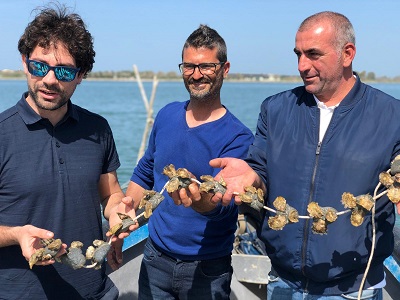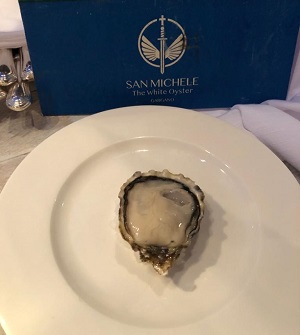San Michele oysters

This expanding farm in the Gargano National Park produces oysters that have an intense and particular flavor.
The San Michele oyster is the first to be farmed in Puglia. It has a sweet, intense flavor with notes of dried fruit and pistachio and is not raised at sea but in the lagoon of Lake Varano, inside the Gargano National Park. Here, the average three-meter depth of the water is suited for off-bottom growing and the water is less salty thanks to two natural springs that reduce the salinity to 24%, compared to 33% in the Adriatic.

The project began in 2017 and was the brainchild of Armando Tandoi, the General Manager of Oyster Oasis, a leader in Italy for the importation and distribution of shellfish, and Vincenzo Falco, President of the Ischiatella Fishermen’s Consortium. A chance meeting in San Severo resulted in a collaborative effort that targets top restaurants and aims to export in the near future. “The project currently employs 15 people and is in expansion given the great response we have had from the market – Armando Tandoi explained –and we expect to expand both staff and production, which should rise from 20 to 50 tonnes over the next two years. All the sea area in Puglia is suited for shellfish farming but results are not guaranteed. For this skill and ideal conditions are needed to achieve quality”.
The oyster is named after the Archangel who protects the Gargano peninsula, and there is a strong connection with the Monte Sant’Angelo sanctuary and Mont Saint-Michel in Brittany, which is famous for its production of mollusks. The latter was built on top of a stone brought from the sanctuary in Puglia by a monk returning from a pilgrimage. The process for raising San Michele oysters begins with placing seed oysters in the water and letting them, after a many months, reach a suitable size. They are then attached, three at a time, to ropes anchored to cement blocks with each cord hosting around 45 oysters at the end. After some two years, the oysters begin to spawn and reproduce after which the oysters are picked, cleaned and packaged for retail sale.

“Oysters should be consumed after a least four days from when they have been picked, this way the meat is less watery, more crispy, intense and flavorful – Armando Tandoi underscored – They should be opened just before consumption and I suggest this be done using the proper tools to avoid any injury or damage to the shell. The best place to insert the blade is in the “hinge” uniting the two shells from where you can cut the main muscle after which the oyster will open”.
The oyster is considered a luxury food item but it is also a healthy food source. Its levels of selenium, copper and zinc help bolster the immune system while the free radicals contain phosphorus and iron, which are excellent anti-fatigue elements, and are rich in eicosapentaenoic and docosahexaenoic fatty acids which are part of the omega 3 family and are beneficial to the cardiovascular system and help the brain with its cognitive functions and those related to sight.

 Italiano
Italiano








